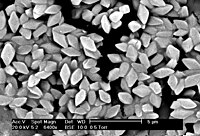
Photo from wikipedia
Despite Bacillus thuringiensis is the most widely used bacterium in biological pest control, its ecology has been notoriously neglected. Its role in nature is uncertain and a defined habitat and… Click to show full abstract
Despite Bacillus thuringiensis is the most widely used bacterium in biological pest control, its ecology has been notoriously neglected. Its role in nature is uncertain and a defined habitat and a niche is under discussion. In this report wildtype strains were isolated from the inner plant tissues, as natural endophytic bacteria in wild plants. Once a reliable superficial sterilization technique was standardized, leaf samples from 110 wildlife plant species, within 52 families, were processed to obtain their endophytic microflora, able to grow in artificial media. Form 93 morphologically different isolates, 22 showed the typical sporangium morphology of B. thuringiensis (endospore and parasporal bodies). These isolates were identified and characterized by their 16S ribosomal RNA, hag gene, MLST, and cry gene sequences. Also, isolates were characterized by Bc-RepPCR and parasporal body protein content. All the isolates showed at least some of the typical B. thuringiensis features tested, but 10 showed information in all those features, which, in a rigorous selection, were taken as B. thuringiensis sensu stricto strains. Only three subspecies were identified: five kurstaki, four nigeriensis, and one thuringiensis. None showed toxicity against mosquito larvae and Caenorhabditis elegans, and only one showed significant toxicity against Manduca sexta larvae. The role of B. thuringiensis as a natural endophytic bacterium is discussed.
Journal Title: FEMS microbiology ecology
Year Published: 2023
Link to full text (if available)
Share on Social Media: Sign Up to like & get
recommendations!